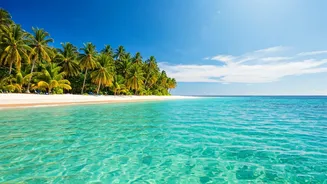A Coastal Confluence
India's coastline is a tapestry of various geographical features, but there's a particular spot that stands out: a place where the Arabian Sea and the Bay
of Bengal converge. The meeting point is a remarkable example of nature’s ability to create unique environments. The precise location of this phenomenon adds to the intrigue, showcasing the country's diverse topography. This coastal setting highlights the dynamic interaction of water bodies, influencing ecosystems and shaping the regional climate. This convergence offers an opportunity for observing the powerful effects of the ocean currents and the interplay of different marine environments. Exploring this specific locale unveils the intricate details of India's coastal regions.
Geographic Uniqueness Unveiled
The existence of a spot where both the Arabian Sea and the Bay of Bengal interact is highly unusual and adds to the site's importance. This unusual arrangement is a consequence of India's specific geographical contours and its strategic position along the Indian Ocean. Its position represents a rare geographical phenomenon. Understanding the area's geological features helps explain its distinctiveness. The confluence of these seas affects the region's climate patterns, generating a variety of weather conditions. The coastal location is essential for marine life and plays an important role in ecological processes. This area provides a natural laboratory for studying coastal dynamics, tidal variations, and the exchange of water masses between the two seas.
Impact on the Region
The location where the Arabian Sea and the Bay of Bengal meet has a considerable effect on the surrounding area. The meeting of these two bodies of water influences the local weather patterns, bringing about different seasonal shifts and temperature ranges. The convergence promotes the movement of water and nutrients, which has a positive impact on marine life. This area serves as a focal point for both local ecosystems and the broader oceanic environment, as it facilitates the blending of distinct marine characteristics. Understanding the impact of this meeting point on the environment and the economic activities of the local population is important for its protection.
Environmental Importance Examined
The convergence of the Arabian Sea and the Bay of Bengal is of high environmental importance. This geographical meeting zone encourages biodiversity by supporting a rich variety of marine species. Different species of fish, marine mammals, and various other forms of marine life thrive. Moreover, the area may host unique habitats, such as estuaries and coastal wetlands, which are necessary for the ecological balance. This junction is critical in keeping the balance of the coastal ecosystems. Studying this intersection can also contribute to understanding the effects of climate change and human impact on marine ecosystems.
Exploring its Significance
The unique coastal environment has diverse implications, including ecological, climatic, and scientific significance. For scientists, this spot offers a chance to research complex oceanographic interactions, such as water exchange and the mixing of different water masses. From a climatic perspective, the area's position in relation to the sea influences the weather patterns and rainfall distribution. Economically, this convergence may offer advantages in sectors like fisheries and tourism. Recognizing the wide range of effects linked to the location enhances the ability to appreciate its value and support sustainable resource management.













